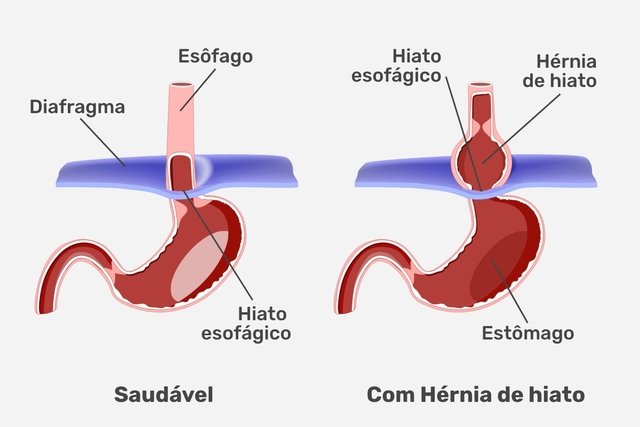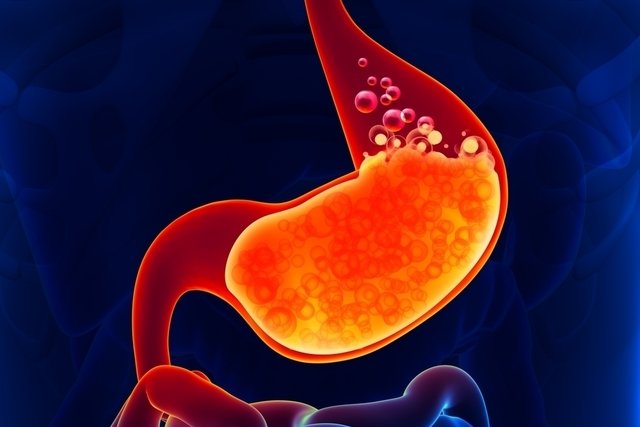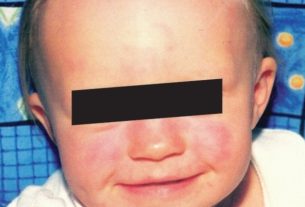A hiatus hernia is when the stomach passes through the esophageal hiatus of the diaphragm, causing a portion of the stomach to remain in the chest cavity. The esophageal hiatus is the hole present in the diaphragm, which normally only allows the esophagus to pass through.
A hiatus hernia, also called hiatal hernia, arises due to the weakening of the muscular tissue of the diaphragm, which ends up allowing the stomach to pass through. When this happens, symptoms such as heartburn, gastroesophageal reflux or a burning sensation in the throat may appear.
Hiatal hernia treatment must be carried out under the guidance of a gastroenterologist, who may recommend the use of medication to reduce stomach acidity and alleviate symptoms, or surgery in more serious cases.

Hiatal hernia symptoms
The main symptoms of a hiatal hernia are:
- Heartburn or burning in the stomach;
- Regurgitation of food or drinks into the mouth;
- Burning sensation in the throat;
- Difficulty swallowing;
- Chronic, dry and irritating cough;
- Frequent bitter taste;
- Bad breath;
- Frequent burping;
- Feeling of slow digestion;
- Frequent urge to vomit;
- Chest pain;
- Dor abdominal;
- Shortness of breathe.
Furthermore, in more serious cases, gastrointestinal bleeding and symptoms such as bloody vomiting or black stools may occur.
Small hiatus hernias normally have no symptoms, however, when the hernia is large, symptoms usually appear around 20 to 30 minutes after meals and tend to disappear shortly afterwards.
It is important to consult a gastroenterologist whenever hiatal hernia symptoms appear, so that the diagnosis can be made and the most appropriate treatment can be initiated.
How to confirm the diagnosis
The diagnosis of hiatus hernia is made by the gastroenterologist through the evaluation of symptoms and health history, and is confirmed through imaging tests, such as X-ray with barium contrast, computed tomography, upper digestive endoscopy, esophageal manometry or esophagram, for example . Find out how an esophagram is performed.
Imaging tests for hiatus hernia are important not only to confirm the diagnosis, but to rule out other health conditions that may have similar symptoms, such as gastroesophageal reflux disease, achalasia, diverticulitis, peptic stricture, tumor, or primary motor disorder. , for example.
Possible causes
A hiatal hernia is caused by the weakening and loss of flexibility and elasticity of the esophageal hiatus, which is a hole present in the diaphragm muscle, which separates the chest from the abdomen. In this way, part of the stomach ends up rising through the esophageal hiatus, causing symptoms.
Some factors may contribute to the development of a hiatus hernia, such as:
- Age, being more common after age 50;
- Obesity;
- Pregnancy;
- Chronic constipation;
- Chronic obstructive pulmonary disease (COPD);
- Chronic cough;
- Gastroesophageal reflux disease;
- Traumas;
- Thoracoabdominal aortic aneurysm;
- Previous esophageal surgeries;
- Partial or total gastrectomy.
Furthermore, a hiatal hernia can also arise due to excessive physical activity that requires a lot of strength, such as lifting weights, for example.
Can a hiatal hernia turn into cancer?
Hiatal hernia does not turn into cancer, however, due to the constant reflux of acid from the stomach into the esophagus, it can increase the risk of developing Barrett’s esophagus which leads to a change in the cells of the esophagus and predisposes to the development of cancer, especially of esophageal adenocarcinoma. Know how to identify the symptoms of esophageal cancer.
How the treatment is carried out
The treatment of a hiatal hernia must be carried out under the guidance of a gastroenterologist, who may indicate:
1. Hiatal hernia remedies
The most commonly used medications for hiatal hernia are proton pump inhibitors, antacids or histamine receptor antagonists, such as omeprazole, aluminum hydroxide or cimetidine, for example, which help to alleviate reflux symptoms. Check out other remedies for gastroesophageal reflux.
2. Diet changes
Dietary changes also help alleviate the discomfort caused by a hiatus hernia. These changes include: avoiding the consumption of foods with a lot of fat or very spicy foods, avoiding alcoholic beverages and giving preference to lighter and smaller meals.
Watch the following video with dietary tips to alleviate hiatal hernia symptoms:
3. Surgery for hiatal hernia
Surgery for hiatal hernia is only indicated in more serious cases and when the use of medication and dietary care were not enough to alleviate the symptoms caused by gastroesophageal reflux or when the hernia is strangulated, for example.
This type of surgery is performed through laparoscopy, under general anesthesia and full recovery takes about 2 months. Understand how surgery for gastroesophageal reflux is performed.
Bibliography
- ANDRICI, J.; et al. Hiatal hernia and the risk of Barrett’s esophagus. J Gastroenterol Hepatol. 28. 3; 415-31, 2013
- YU, HX.; et al. Esophageal hiatal hernia: risk, diagnosis and management. Expert Review of Gastroenterology & Hepatology. 12. 4; 319–329, 2018
- SAMKARI, E.; ALSHALAWI, M. Hiatal hernia. Pan Afr Med J. 24. 40, 2016
- KOHN, GP; et al. Guidelines for the management of hiatal hernia. Surg Endosc. 27. 12; 4409-28, 2013
- WU, AW; et al. Hiatal hernia, reflux symptoms, body size, and risk of esophageal and gastric adenocarcinoma. Cancer. 98. 5; 940-8, 2003
- KIM, P.; et al. Hiatal hernia classification-Way past its shelf life. Surgery. 170. 2; 642-643, 2021
- SMITH, R. E.; SHAHJEHAN, R. D. IN: STATPEARLS (INTERNET). TREASURE ISLAND (FL): STATPEARLS PUBLISHING. Hiatal Hernia. 2022. Available at: <https://www.ncbi.nlm.nih.gov/books/NBK562200/>. Accessed on Jul 25, 2022
- Yu, HX; et al. Esophageal hiatal hernia: risk, diagnosis and management. Expert Rev Gastroenterol Hepatol. 12. 4; 319-329, 2018
- PHILPOTT, H.; SWEIS, R. Hiatus Hernia as a Cause of Dysphagia. Curr Gastroenterol Rep. 19. 8; 40, 2017
- Federle, Michael P. Imaging Diagnosis: Gastrointestinal. 1 ed. Rio de Janeiro: Elsevier, 2018. p. 3.

Sign up for our newsletter and stay up to date with exclusive news
that can transform your routine!
Warning: Undefined array key "title" in /home/storelat/public_html/wp-content/plugins/link-whisper-premium/templates/frontend/related-posts.php on line 12
Warning: Undefined array key "title_tag" in /home/storelat/public_html/wp-content/plugins/link-whisper-premium/templates/frontend/related-posts.php on line 13





